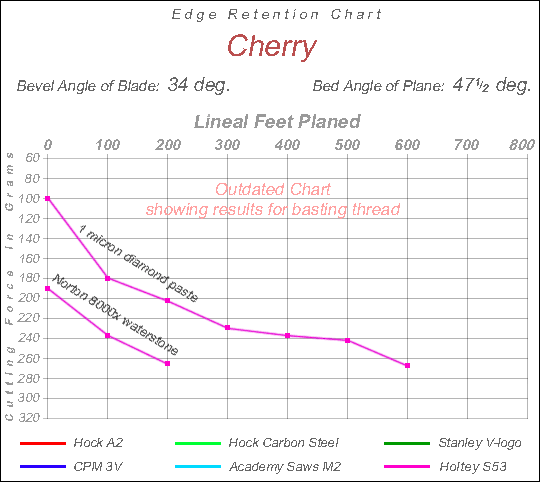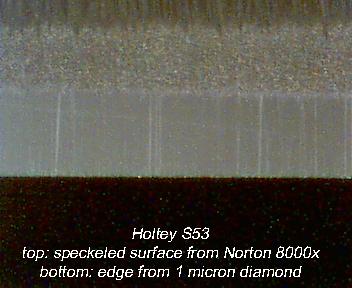Different alloys require different types of abrasive to achieve a sharp edge. I learned this by trying to produce a very sharp edge on the heavily carbided S53 blade by Holtey using a Norton 8000x waterstone. That stone had produced very sharp edges on other blades, and I wanted all the blades I compared to be sharpened identically. In my first comparison test, the S53 blade rated poorly in both initial sharpness and edge retention. I was surprised by this because it had performed significantly better when I had sharpened it using 1 micron diamond paste.
I rehoned the S53 blade using diamond paste and retested it for sharpness. Instead of its previous initial “sharpness” of 190 grams, it came in at 100 grams, which put it among the sharpest blades. (These tests were done back when I was using basting thread. If rayon thread had been used, the values would have been about 125 g for the Norton and 65 g for the diamond.)
Here’s a chart that compares the initial sharpness and edge retention of the Holtey S53 blade when honed with the Norton 8000x waterstone and 1 micron diamond paste:

My experience as I honed the S53 blade on the Norton waterstone may explain why the edge produced was of poorer quality.
When I started honing, the stone barely cut for quite a while. As a slurry developed on the stone it began to cut better. Pretty soon it was cutting surprisingly fast. I now believe what happened was that as the stone began to remove metal, the carbide particles released from the steel matrix mixed into the slurry and became its primary cutting agent. Because these carbide particles are much larger than the grit in the Norton stone, and harder as well, the surface produced on the blade was less refined than the surface usually produced by the Norton on other steels.
When I rehoned using 1 micron diamond, the new surface produced had a distinctly different appearance. Here is a microscope image that shows both types of surface:

Just below the dark band at the top is a speckled surface produced by the Norton stone, presumably with the carbides mixed into the slurry. Below that is a band of more uniform gray with vertical scratches that was produced by the 1 micron diamond.
To see if this difference between waterstone and diamond held for the CPM 3V blade, I rehoned it using diamond and found that its initial sharpness remained at 150 grams. When I switched to ½ micron diamond paste the sharpness increased to 90 grams, almost matching the best sharpness of any blade. (If these test had been done using rayon thread, the results would have been about 100 grams for the 1 micron and 60 grams for the ½ micron diamond.) I suspect the result for 1 micron may be due to poor honing technique, and that better honing would have produced a sharper edge. I hope to repeat this comparison using rayon thread.
For the edge retention tests all of the honing is being done with ½ micron diamond paste because it has produced very sharp edges on all of the blades.
More recent sharpness tests have shown that chromium oxide is hard enough to cut the vanadium carbide in the CPM 3V blade. Microabasive paper coated with 0.5 micron CrO produces an edge at least as sharp as that produced by ½ micron diamond. The CrO paper cut much more slowly than diamond.
I believe CrO microabrasive paper will produce a very sharp edge on all of the blades except possibly the Holtey S53.
Since these tests were done the CrO paper has become unavailable, but other forms of CrO should produce similar results.